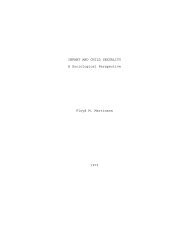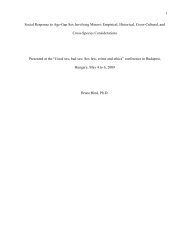PDF file - Ipce
PDF file - Ipce
PDF file - Ipce
You also want an ePaper? Increase the reach of your titles
YUMPU automatically turns print PDFs into web optimized ePapers that Google loves.
Book reviews<br />
Though Sonenschein focuses on American twentieth-century popular culture, he covers a great<br />
deal of historical ground. His may be the most detailed examination ever of the construction of<br />
child molester. For this reason alone, it is an important contribution.<br />
Sonenschein notes homosexuals have been just one in a long list of child threatening figures. He<br />
shows what had been a homosexual threat to youth became in the late 1970s a pedophile threat<br />
as the moral right shifted its energies to easier targets.<br />
Although Sonenschein observes gays and lesbians were among the first to protest the child-sex<br />
panic originating with Anita Bryant’s campaign, he does not point out how those analyses—e.g.<br />
by Gayle Rubin (1978, 1984) and Pat Califia (1980)—turned out to be the high-water mark in<br />
critical assessment, or how, by the end of the 1980s, the gay community's ambivalence as seen in<br />
Der Kreis had become hostility.<br />
Der Kreis' editorial against Eros paidikos came about halfway through its life and coincided with<br />
one of the U.S. child-sex panics described by Jenkins. It marked a change in how the North<br />
American homosexual-rights movement, still in its infancy, viewed sex with young people.<br />
Hubert Kennedy's study shows Der Kreis had earlier published numerous short stories and<br />
poetry about men and youths in sexual relationships, including drawings of pubescent boys.[iii]<br />
Indeed, pederast themes had been present in gay publications since the beginning of the modernday<br />
struggle for homosexual rights.<br />
The world’s first homosexual publication, the German journal Der Eigene (The Self-Owner),<br />
regularly extolled pedagogical eros (Oosterhuis & Kennedy, 1991). Sonenschein cites Friedrich<br />
Kröhnke as showing many homosexual activists in 1930s Germany were pederasts. The editor of<br />
Der Kreis quoted at the outset of this review reacted against Eros paidikos precisely because it<br />
had been an acceptable topic for discourse among homosexuals and lesbians.<br />
Up to the early 1980s, gay / lesbian publications in North America and Europe echoed this<br />
heritage. Widely read and/or critically regarded newspapers and magazines such as The<br />
Advocate (San Mateo, California), Gay Community News (Boston), The Body Politic (Toronto), Gay<br />
News (London), Gai Pied (Paris)—all but the first no longer published—went beyond child-sex<br />
scandals to explore ethical and cultural issues around youth and adults in relationships.<br />
Nowadays only a few publications such as The Guide (Boston) and Anarchy (Columbia, MO)<br />
critically cover political issues relating to adult-child sex. Eros paidikos has faded into<br />
obscurity.[iv]<br />
Both Jenkins and Sonenschein conclude the laws arising from child-sex panics are based on<br />
ideology more than science and do more harm than good. They try to step outside the Western<br />
proscription against children as sexual to illuminate how and why this ideology succeeded. The<br />
two books are a worthwhile complement for anyone seeking a more informed view of the<br />
cultural forces at work around these divisive issues.<br />
http://home.wanadoo.nl/ipce/newsletters/e_14/reviews.htm (5 of 9) [10/16/2002 5:34:25 PM]
















